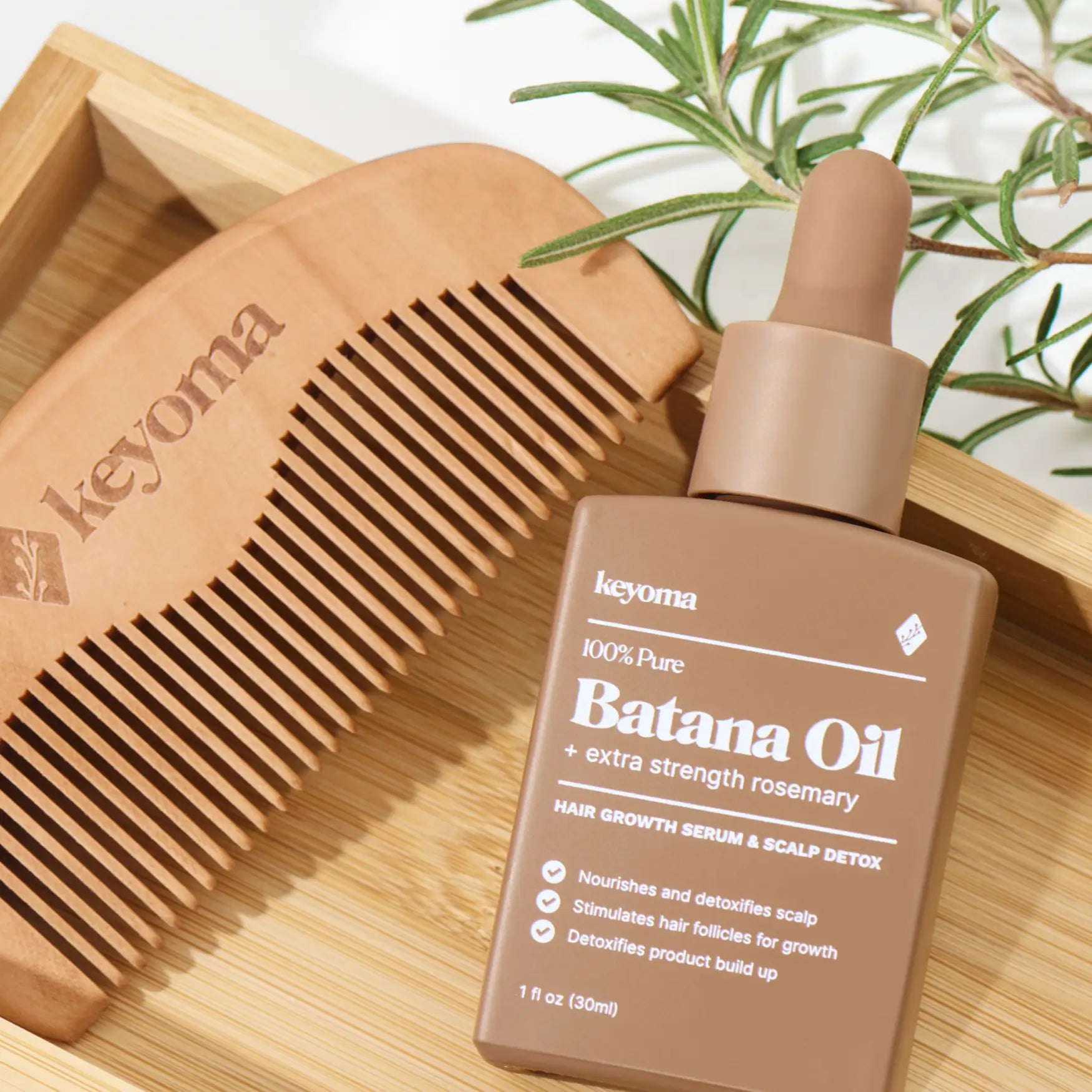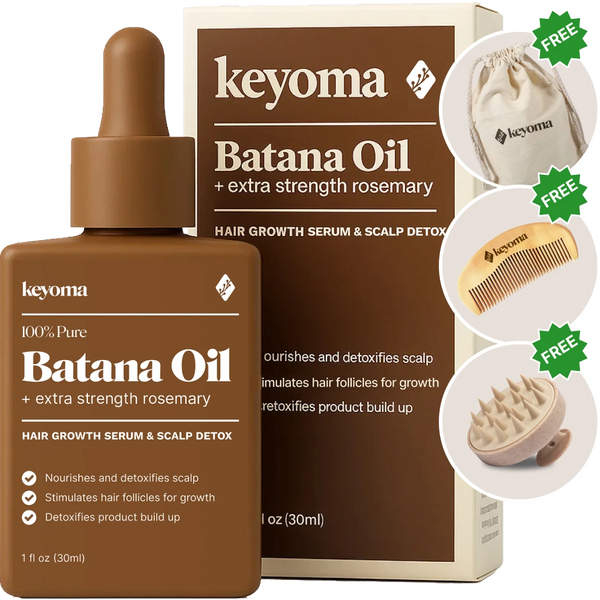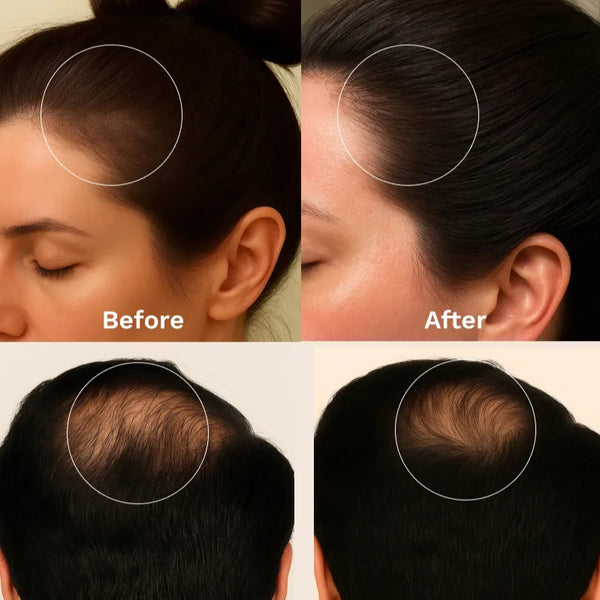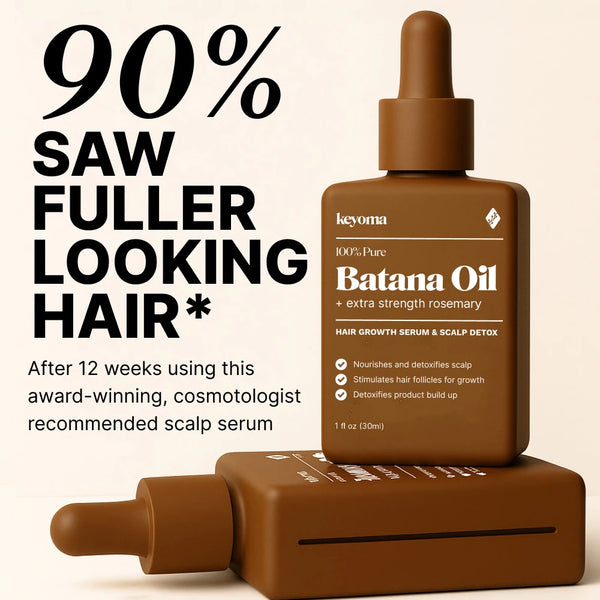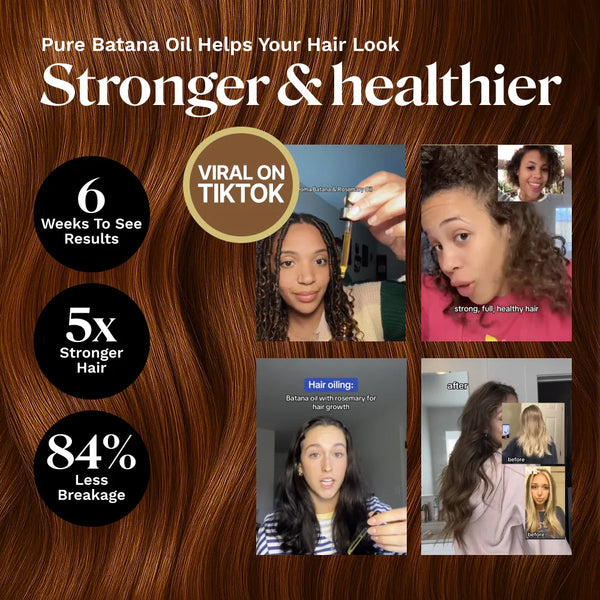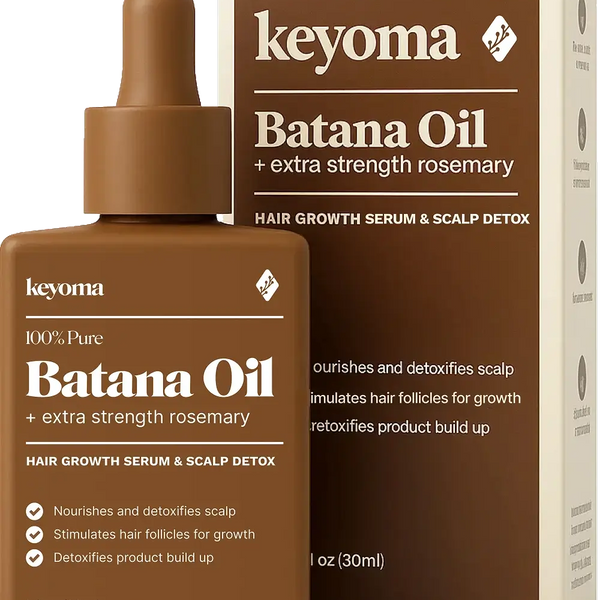In this article
They say a bad hair day can ruin your mood, but split ends take it up a notch (raise your hand if you agree). You brush them down, drown them in serum, yet somehow, these stubborn little things find their way back, impossible to ignore.
Fortunately, there’s a way to stop them from getting worse and make your hair look healthier in the meantime. In this guide, I’ll walk you through how to hide, get rid of, and most importantly, prevent split ends, so you can finally break free from that seemingly endless cycle of frustration.
What Are Split Ends?
Split ends are the frayed or separated tips of your hair strands, usually splitting into two parts at the end (a small Y-shape) and even three parts at times.
This happens when the protective outer layer, called the cuticle, wears away. Once that layer weakens, the inner cortex becomes exposed, causing the strand to thin out, feel dry and rough, and make your hair look uneven overall.
What Causes Split Ends?
Several factors and habits can cause split ends:
-
Heat styling: Frequent use of flat irons, curling wands, or blow dryers strips away moisture and damages the cuticle.
-
Chemical treatments: Bleaching, dyeing, perming, and relaxers all alter the structure of your hair shaft. Repeated exposure to strong chemicals lifts the cuticle scales and leads to breakage at the ends.
-
Friction and rough handling: Brushing too harshly, towel‑drying aggressively, or using elastics that pull tightly can all cause mechanical stress that frays the ends. Even friction from rough cotton pillowcases or tight hairstyles contributes to damage over time.
-
Environmental stressors: UV rays, pollution, and dry air weaken the hair’s lipid barrier and draw moisture out of the shaft. The same goes for exposure to salt and chlorine during beach trips and vacations.
-
Nutritional gaps: Lacking key nutrients like protein, iron, zinc, and omega‑3 fatty acids may compromise hair strength from within. Hair is made mostly of keratin, so poor nutrition can make it more prone to splitting.
What Happens if You Don't Trim Split Ends?
Not trimming split ends only causes them to worsen. The split travels upward along the strand, and by the time it reaches the mid-lengths, your hair appears more uneven and less full. At the same time, it becomes weaker, thinner, and more prone to breakage.
That means even if you’re growing your hair long, ignoring trims can lead to dull, lifeless ends that snap easily.
Hair with split ends also becomes harder to style. It won’t hold curls, straighteners, or braids as well, and the uneven texture makes frizz stand out more. Rough edges scatter light, which takes away shine and softness.
How to Get Rid of Split Ends in Hair
The only real way to get rid of split ends and prevent them from traveling up the hair shaft is to cut them off.
Once a strand splits, that damage is permanent, and no serum or conditioner can molecularly fuse the broken fibers back together.
You can remove split ends in hair through these approaches:
Cut Split Ends Yourself
Getting rid of split ends at home is possible, as long as you take your time and use the right tools. Here’s a step‑by‑step way to remove your own split ends safely and effectively:
-
Spot the split ends: Look for dry, frayed, or Y‑shaped tips under good light. You can also twist small sections of hair to make the damaged ends stand out.
-
Prepare your tools: Use sharp hair‑cutting shears. Regular scissors can crush the ends instead of cutting cleanly, which leads to more fraying.
-
Work in sections: Divide your hair into small parts so you can see the ends clearly. Clip away the rest to stay organized.
-
Trim the splits: Twist one section gently, then snip off the uneven or frayed bits that stick out. Aim to remove just a few millimeters from the ends.
-
Check your work: Run your fingers along each section. If the tips feel smooth, you’ve trimmed correctly.
Professional Micro-dusting
A professional stylist can perform a precise light trim or a technique called micro-dusting. Here, they use extremely sharp shears for clean, even cuts, along with sectioning combs and precision clips that separate strands clearly under strong salon lighting.
Beyond accuracy, visiting a salon also means catching damage you might otherwise miss when trimming your split ends at home—and that happens more often than you’d think.
They can even tailor the trim to match your haircut shape, making sure your hair keeps its bounce and symmetry after the ends are removed.
All that said, this level of care ultimately comes from skill and years of experience, though top-of-the-line tools certainly help achieve that polished finish.
How to Hide Split Ends
Some methods can’t remove split ends, but you can make them look smoother almost instantly. So when people search for how to get rid of split ends overnight, what they often mean is how to hide them well enough that the damage isn’t obvious.
Apply Styling Cream to Damp Hair
A styling cream, especially one containing lightweight silicones or conditioning agents like fatty alcohols and amino acids, works by forming a thin, flexible film around the outer layer of each strand.
This smooths the surface, reflects light evenly, and gives your hair a softer, more uniform look, which explains why it's often regarded as an effective quick fix to disguise the appearance of split ends.
Apply a pea‑sized amount and distribute it from mid‑lengths to ends. Damp hair helps the product spread evenly without overloading the roots.
Keep in mind that while styling cream offers a quick fix, overusing it can cause buildup. So wash it out regularly with a gentle, sulfate‑free shampoo to maintain clean, balanced hair.
Use Hair Oil to Smooth the Splits
Hair oil works as a temporary way to conceal split ends because it fills the tiny gaps and cracks along the damaged cuticle.
Many oils contain nourishing components like fatty acids, antioxidants, and lightweight lipids. These ingredients coat the surface of each strand, creating a smooth, reflective finish. As a result, split ends appear softer and less noticeable.
Argan oil, jojoba oil, and batana oil are among the top options that often come up in conversations about the best oils for repairing split ends.
When applying, remember the goal is a light coating. Warm one or two drops between your palms, then work it gently through the mid‑lengths and ends.
Use Hairspray to Tame Flyaways
Much like how styling creams and hair oils work as temporary fixes, hairspray helps disguise split ends by using polymers that form a light film to hold frayed tips close together.
When applying, choose a flexible-hold formula to avoid stiffness while still keeping the ends in place. Spray it onto your hands (not directly on your hair) rub your palms together, then pinch the ends gently.
How to Prevent Split Ends
Learning how to prevent split ends at home starts with simple habits that keep the cuticle smooth and flexible. And if you’ve ever wondered how to get rid of split ends naturally, the steps below show you the everyday choices that protect your ends before they dry out or crack.
Book Regular Trims
As mentioned earlier, trimming your hair is the only real solution to split ends. That makes booking regular trims the most effective way to prevent them from coming back.
But how often should you trim split ends?
Most people see the best results with trims every eight to twelve weeks. If your hair is chemically treated, very long, or frequently styled with heat, aim for a slightly earlier schedule of around every six weeks.
Wash with a Nourishing Shampoo
A nourishing shampoo helps prevent split ends by keeping the cuticle clean and hydrated. This slows down the dryness that normally leads to cracking at the ends.
When looking for a shampoo, choose those with fatty alcohols such as cetyl or cetearyl, amino acids, aloe, or ceramides. Avoid strong sulfates, high alcohol content, and harsh clarifiers unless you need an occasional deep cleanse, a
Now, choosing a shampoo is one thing, but something that's just as important is how you wash your hair. Below are some pointers to keep in mind:
-
Match your routine to your hair type. Oily scalps may need more frequent washing, while dry or curly hair usually benefits from fewer wash days so natural oils can travel toward the ends.
-
Use lukewarm water. Hot water strips away moisture quickly and leaves the ends rough, so keep the temperature moderate when rinsing.
-
Always follow with conditioner. Apply conditioner on the mid-lengths and ends to smooth lifted cuticle scales and reduce friction during styling.
-
Add leave-in for extra protection. If your hair still feels dry, a lightweight leave-in conditioner adds slip and softness that help guard the ends throughout the day.
Use a Hair Mask Weekly
Masks work by delivering concentrated ingredients that reach deeper into the hair shaft than regular conditioner. This keeps your ends strong and hydrated, which helps prevent split ends before they start.
Some tips when using a mask:
-
Apply from mid‑lengths to ends. These areas need the most support since they’re older and drier.
-
Leave it on long enough. Most masks need at least five to ten minutes so the ingredients can settle into the cuticle.
-
Rinse with cool or lukewarm water. This keeps the cuticle smooth.
To be one hundred percent clear, do this only once a week as daily masking can leave buildup, especially on fine hair.
Dry Hair With a Microfiber Towel
Microfiber strands are much finer than the regular cotton that most towels are made over. They glide over the hair instead of tugging at it, minimizing or even completely avoiding the possibility of tiny cracks that eventually turn into split ends.
Just keep in mind to blot, don't rub as rubbing would otherwise cause unnecessary friction that weakens the ends (or make existing splits worse)
Use a Hair Oil to Treat Brittle Hair
Earlier, we mentioned hair oils as a great way to temporarily fix and hide split ends. But the truth is, they’re more of a preventive step not just for split ends but for overall hair damage.
That’s why it’s no surprise that traditional Ayurvedic oils, passed down through generations, remain staples in hair care even today.
Hair oils like coconut, jojoba, and batana, work preventively by slowing down moisture loss and keeping the ends hydrated for as long as possible. That’s thanks to their rich fatty acids, which fill the tiny gaps along the cuticle and help seal in softness.
Always use just a few drops, since heavy application can weigh hair down, especially if it’s fine.
Brush Your Hair Gently
Brushing your hair gently helps prevent or lower the risk of split ends in many ways.
-
It reduces friction, which means fewer lifted cuticle scales.
-
It distributes natural oils throughout the length of each strand
-
It prevents tugging, which if not prevented, can snap weak ends and create new splits.
Some pointers to remember when brushing your hair:
-
Start from the bottom. Work through tangles at the ends first, then move upward. This avoids dragging knots along the full strand.
-
Use the right tool. Choose a wide‑tooth comb for wet hair and a soft‑bristle brush for dry hair.
-
Avoid brushing hair when it’s soaking wet. Wet strands lose elasticity easily, and that raises the risk of breakage. If you need to detangle in the shower, use a wide‑tooth comb with conditioner for slip.
Minimize Heat Styling
There’s nothing wrong with occasional heat styling. But using heat daily (especially at high temperatures) can weaken the cuticle and drain moisture from the strand. Over time, this damages the protective layer and causes the ends to crack and fray.
If you need to use heat every day or more often than you’d like, here are a few things to keep in mind:
-
Use a heat protectant every time. Look for products with silicone blends, amino acids, or polymers that coat the strand lightly.
-
Dial in safer temperatures. Most stylists recommend keeping hot tools between 150 °C and 180 °C for most hair types. Thick or coarse hair can handle slightly higher settings, but avoid going near extreme heat.
-
Limit pass counts. Glide the tool slowly with fewer passes instead of multiple quick ones. Fewer passes reduce cumulative heat exposure.
-
Dry hair completely before styling. Heat on damp hair boils the water inside the strand and increases breakage.
-
Beware of old, uneven-heating tools. Older flat irons and curling wands often develop hotspots that burn certain sections unevenly.
Sleep with a Silk Pillowcase
Sleeping with a silk pillowcase helps prevent split ends because silk lowers friction on the hair cuticle. Low friction keeps the outer layer smooth instead of scraped or lifted, and that protects the ends from the tiny cracks that eventually turn into splits.
Tips when using a silk pillowcase:
-
Choose real silk, not satin polyester. Satin can still help, but real mulberry silk works better at reducing friction.
-
Keep the pillowcase clean. Oils and product buildup on fabric can transfer to the hair and weigh down the ends.
-
Pair it with loose hairstyles. A loose braid or low ponytail at night keeps strands from twisting and rubbing.
Protect Your Hair From the Sun
UV exposure can weaken the cuticle and dry out the hair shaft. When the cuticle loses its lipids and moisture, it becomes brittle and tends to crack easily. Once that happens, the split moves upward.
That said, whether you’re working outdoors or traveling soon for a beach getaway, keep these measures in mind:
-
Use a UV‑protectant spray. Look for ingredients like benzophenone‑4, ethylhexyl methoxycinnamate, or antioxidant blends that help shield the cuticle.
-
Wear a hat outdoors. A wide‑brim hat or bucket hat gives instant shade and lowers UV impact on the ends
-
Apply a light layer of oil before swimming. Oils form a temporary barrier that slows down moisture loss in saltwater or chlorinated pools.
-
Rinse after swimming. Salt and chlorine dry the cuticle fast. Rinsing reduces the time they stay on your hair.
Head over to our Summer Hair Care Tips guide for more details on keeping your hair safe from the sun and heat.
Eat a Healthy, Balanced Meal
Nutrition is an integral part of holistic hair care. When your body lacks certain vitamins, minerals, and proteins, your cuticle can weaken easily, becoming thin or dehydrated. The ends lose flexibility and eventually begin to crack.
In that regard, make sure to:
-
Build meals around whole foods. Lean proteins, leafy greens, nuts, seeds, and fruits support stronger, smoother ends over time.
-
Stay hydrated. Water helps maintain moisture along each strand so the ends stay flexible instead of brittle.
-
Take supplements if you have deficiencies. This especially applies to certain diets, like vegan or restrictive ones, but do so only under professional advice.
-
Avoid or minimize sugar intake. Excess sugar can trigger inflammation and weaken collagen around your follicles, which affects overall hair strength.
Can You Fix Split Ends Without Cutting?
You can’t fully fix split ends without cutting. A split end is permanent damage, and the only real way to repair it is by trimming. Cutting removes the weakened tip and stops the split from traveling higher up the strand.
What most people call a split end “treatment” usually refers to products that make the ends look smoother, such as serums, styling creams, or hairsprays.
These don’t repair or reverse the damage. They simply disguise it and make hair easier to manage until you’re ready for a permanent fix.
Is it Okay to Break Split Ends?
Breaking split ends is not okay. It makes the damage worse because breaking, tearing, or biting the tip tears the cuticle unevenly. As a consequence:
-
The split travels higher. Snapping the end forces the cuticle to peel upward, which exposes more of the cortex and speeds up further splitting.
-
The strand weakens. A torn edge frays easily, and the fraying spreads through everyday friction from brushing or styling.
-
You lose more length later. The more the split spreads, the more you’ll need to trim to restore a healthy edge.
Frequently Asked Questions (FAQs)
Do split ends stop hair growth?
Split ends do not stop hair from growing at the root. Your follicles will keep producing new length, which means your hair will still grow even if you don't cut your split ends.
Can oils heal split ends?
Oils cannot heal split ends and fuse broken fibers back together. However, they're an effective way to prevent or minimize the risk of split ends in the long term.
How often should I trim if growing my hair?
If you want to grow your hair long, aim for trims every eight to twelve weeks. This removes the damaged tips before they creep higher.
How do I permanently stop split ends?
You can permanently stop split ends only by cutting the damaged tips, whether you do it yourself or visit a professional stylist. No product can repair a split end at the molecular level. Good hair care habits simply help in the long term by keeping new splits from forming.
Moisturize Daily to Keep Future Splits Away
Once you trim off the split ends, the next goal is to keep the healthy parts from splitting again. The easiest way to do that? Hair-nourishing oils!
Keyoma’s Batana Oil infused with Rosemary is the perfect solution for dry ends that are prone to splitting. Batana helps replenish the lipids that keep the cuticle smooth, while rosemary offers added support through its proven antifungal and hair growth benefits.
Try it today and see how consistent moisture can help your hair stay strong from root to tip.
Featured Product
100% Pure Batana Oil + Rosemary
↓Best Batana Oil to Buy↓
1 Month
Subscribe & Save
- 30-day supply delivered monthly $35
- 30% off for life $6
- Free haircare essentials kit $33
- Free custom wooden comb $10
- Free scalp massager $15
- Free eco-friendly travel bag $8
- 30-Day Money Back Guarantee
- Free Shipping
- Online portal for easy cancel, skip, or pause.
1 Month One Time Purchase
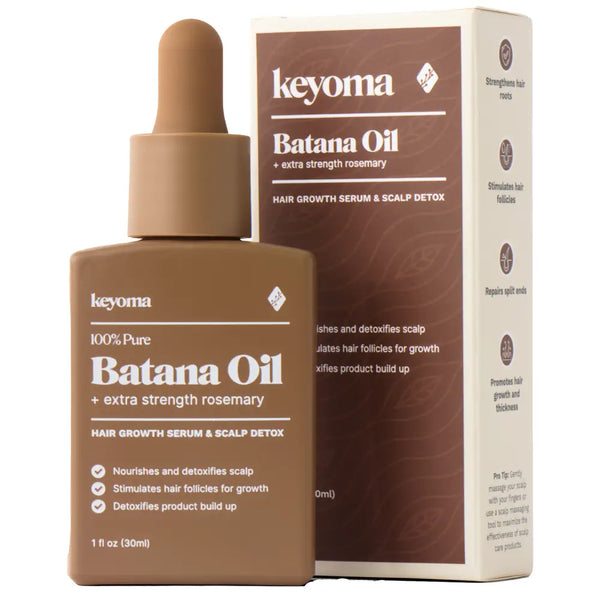
- 30-day supply $50
- 30% off for life $6
- Free haircare essentials kit $33
- Free custom wooden comb $10
- Free scalp massager $15
- Free eco-friendly travel bag $8


